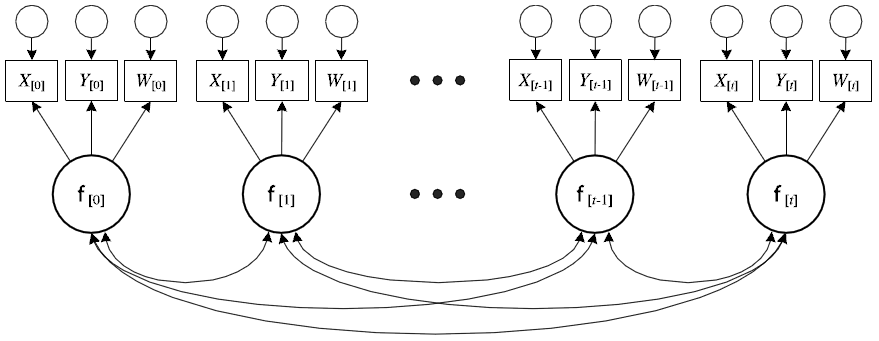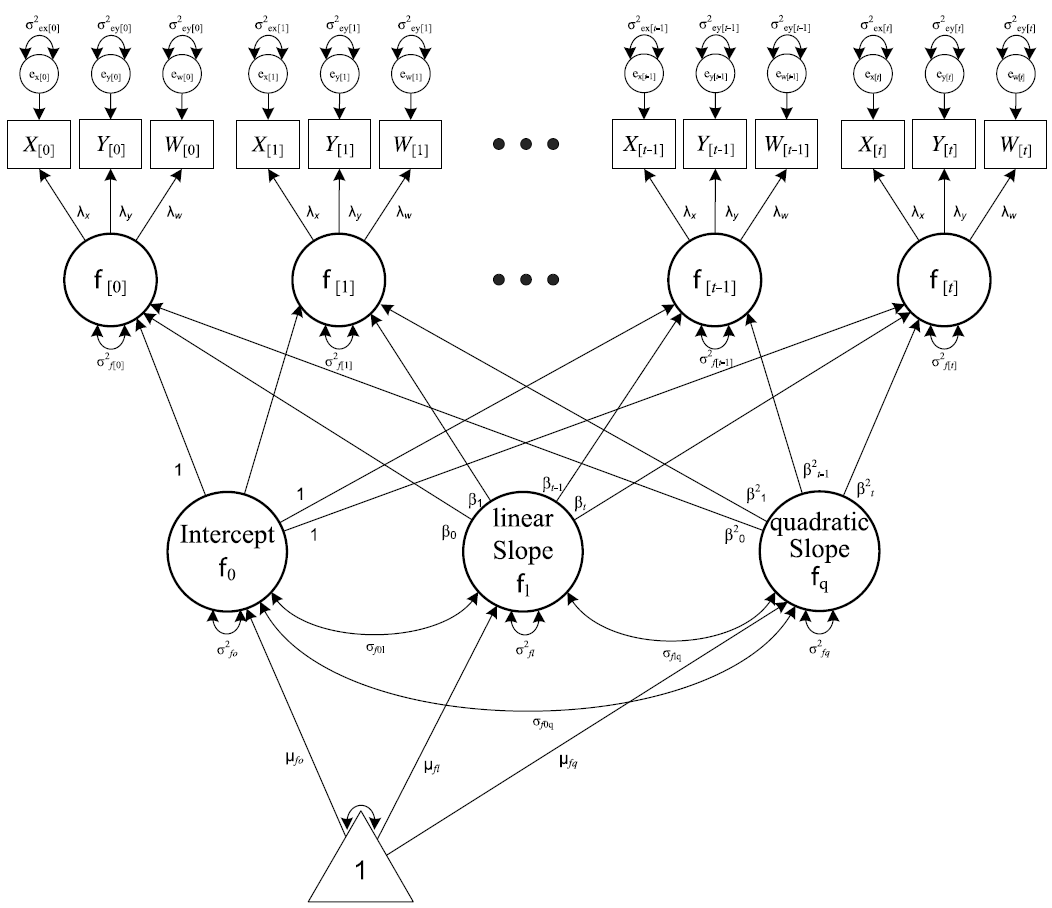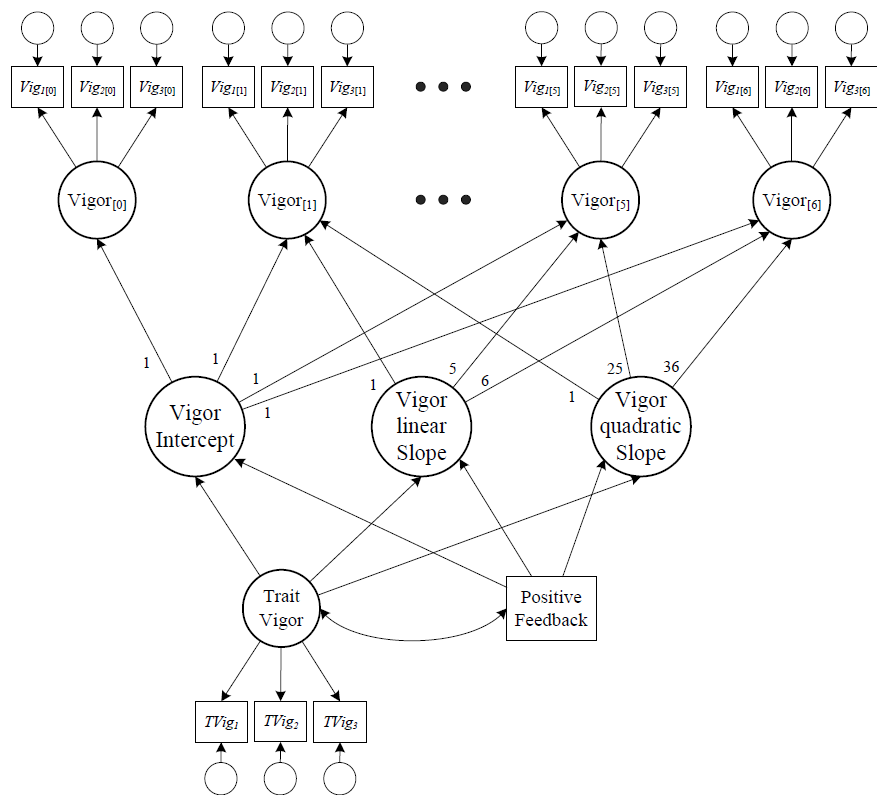
A Day in the Life of a Happy Worker
Here you find supplementary material for the book chapter titled ‘Latent Growth Modeling Applied to Diary Data: The Trajectory of Vigor across a Working Week as an Illustrative Example’.
It is a chapter in the book ‘A Day in the Life of a Happy Worker’, edited by Professor Arnold B. Bakker and Professor Kevin J. Daniels, published by Psychology Press and written by Sven Gross, Laurenz L. Meier and Norbert K. Semmer.
More information about the book on the Psychology Press website.
1 Measurement Model without contstraints (CFA1)
Lines starting with an exclamation mark ( ! ) are syntax comments.
Mplus Syntax
model: !Measurement Model for vigor (lV = latent vigor, vig1_M = first item measurement point t) lV0 BY vig1_M0 vig2_M0 vig3_M0; lV1 BY vig1_M1 vig2_M1 vig3_M1; lV2 BY vig1_M2 vig2_M2 vig3_M2; lV3 BY vig1_M3 vig2_M3 vig3_M3; lV4 BY vig1_M4 vig2_M4 vig3_M4; lV5 BY vig1_M5 vig2_M5 vig3_M5; lV6 BY vig1_M6 vig2_M6 vig3_M6; !Covariances of Uniqueness vig1_M0 with vig1_M1; vig1_M0 with vig1_M1; vig1_M0 with vig1_M2; vig1_M0 with vig1_M3; vig1_M0 with vig1_M4; vig1_M0 with vig1_M5; vig1_M0 with vig1_M6; vig1_M1 with vig1_M2; vig1_M1 with vig1_M3; vig1_M1 with vig1_M4; vig1_M1 with vig1_M5; vig1_M1 with vig1_M6; vig1_M2 with vig1_M3; vig1_M2 with vig1_M4; vig1_M2 with vig1_M5; vig1_M2 with vig1_M6; vig1_M3 with vig1_M4; vig1_M3 with vig1_M5; vig1_M3 with vig1_M6; vig1_M4 with vig1_M5; vig1_M4 with vig1_M6; vig1_M5 with vig1_M6; !! vig2_M0 with vig2_M1; vig2_M0 with vig2_M2; vig2_M0 with vig2_M3; vig2_M0 with vig2_M4; vig2_M0 with vig2_M5; vig2_M0 with vig2_M6; vig2_M1 with vig2_M2; vig2_M1 with vig2_M3; vig2_M1 with vig2_M4; vig2_M1 with vig2_M5; vig2_M1 with vig2_M6; vig2_M2 with vig2_M3; vig2_M2 with vig2_M4; vig2_M2 with vig2_M5; vig2_M2 with vig2_M6; vig2_M3 with vig2_M4; vig2_M3 with vig2_M5; vig2_M3 with vig2_M6; vig2_M4 with vig2_M5; vig2_M4 with vig2_M6; vig2_M5 with vig2_M6; !! vig3_M0 with vig3_M1; vig3_M0 with vig3_M2; vig3_M0 with vig3_M3; vig3_M0 with vig3_M4; vig3_M0 with vig3_M5; vig3_M0 with vig3_M6; vig3_M1 with vig3_M2; vig3_M1 with vig3_M3; vig3_M1 with vig3_M4; vig3_M1 with vig3_M5; vig3_M1 with vig3_M6; vig3_M2 with vig3_M3; vig3_M2 with vig3_M4; vig3_M2 with vig3_M5; vig3_M2 with vig3_M6; vig3_M3 with vig3_M4; vig3_M3 with vig3_M5; vig3_M3 with vig3_M6; vig3_M4 with vig3_M5; vig3_M4 with vig3_M6; vig3_M5 with vig3_M6;
2 Measurement Model with equal factor loadings (CFA2)
Mplus Syntax
model: !Measurement Model for vigor (lV = latent vigor, vig1_M = first item measurement point t, iv2 and iv3 are used to define, which factor loading should be equal across time) lV0 BY vig1_M0 vig2_M0 (iv2) vig3_M0 (iv3); lV1 BY vig1_M1 vig2_M1 (iv2) vig3_M1 (iv3); lV2 BY vig1_M2 vig2_M2 (iv2) vig3_M2 (iv3); lV3 BY vig1_M3 vig2_M3 (iv2) vig3_M3 (iv3); lV4 BY vig1_M4 vig2_M4 (iv2) vig3_M4 (iv3); lV5 BY vig1_M5 vig2_M5 (iv2) vig3_M5 (iv3); lV6 BY vig1_M6 vig2_M6 (iv2) vig3_M6 (iv3); !Code for covariances of uniqueness is the same as in CFA1 vig1_M0 with vig1_M1; vig1_M0 with vig1_M2; vig1_M0 with vig1_M3; vig1_M0 with vig1_M4; vig1_M0 with vig1_M5; vig1_M0 with vig1_M6; !and so forth ...
3 State model or measurement model with equal factor loadings and equal Intercepts (CFA3)
3.1 Figure: Simplified State-Model

3.2 Mplus Syntax
model: !Measurement Model !First two code parts (definition of factors and covariances of uniqueness) are the same as in CFA2 lV0 BY vig1_M0 vig2_M0 (iv2) vig3_M0 (iv3); lV1 BY vig1_M1 vig2_M1 (iv2) vig3_M1 (iv3); lV2 BY vig1_M2 !and so forth ... !covariances of uniqueness vig1_M0 with vig1_M1; vig1_M0 with vig1_M2; vig1_M0 with vig1_M3; vig1_M0 with vig1_M4; vig1_M0 with vig1_M5; vig1_M0 with vig1_M6; !and so forth ... !Intercepts !Estimating intercepts at the latent level [lV0 lV1 lV2 lV3 lV4 lV5 lV6]; !Setting intercepts of the first indicator to zero [vig1_M0@0 vig1_M1@0 vig1_M2@0 vig1_M3@0 vig1_M4@0 vig1_M5@0 vig1_M6@0]; !Setting intercepts of the second indicator to be equal across time [vig2_M0 vig2_M1 vig2_M2 vig2_M3 vig2_M4 vig2_M5 vig2_M6] (ii2); !Setting intercepts of the third indicator to be equal across time [vig3_M0 vig3_M1 vig3_M2 vig3_M3 vig3_M4 vig3_M5 vig3_M6] (ii3);
4 State - Trait Model
4.1 Figure: Simplified State-Trait Model

4.2 Mplus – Syntax
model: !Measurement Model !First three code parts (definition of factors, covariances of uniqueness,intercepts) are the same as in the state-model lV0 BY vig1_M0 vig2_M0 (iv2) vig3_M0 (iv3); !and so forth ... !covariances of uniqueness vig1_M0 with vig1_M1; vig1_M0 with vig1_M2; vig1_M0 with vig1_M3; !and so forth ... !Intercepts [lV0 lV1 lV2 lV3 lV4 lV5 lV6]; [vig1_M0@0 vig1_M1@0 vig1_M2@0 vig1_M3@0 vig1_M4@0 vig1_M5@0 vig1_M6@0]; !and so forth ... !Structural Part !Trait (tVig = latent Trait Vigor) ltVig by lV0-lV6;
5 Linear LGM
5.1 Figure: Linear LGM
Depicted in the figure are most of the parameters that are estimated. The triangle represents a constant to estimate the means and intercepts. Parameters that are estimated but not depicted in this figure are the covariances of uniqueness and the intercepts of the manifest variables.

5.2 Mplus Syntax
model: !Measurement Model !First two code parts (definition of factors and covariances of uniqueness) are the same as in the state-model lV0 BY vig1_M0 vig2_M0 (iv2) vig3_M0 (iv3); !and so forth ... !covariances of uniqueness vig1_M0 with vig1_M1; vig1_M0 with vig1_M2; vig1_M0 with vig1_M3; !and so forth ... !Intercepts !Estimating means of the growth parameter [i s]; !Setting intercepts of the latent vigor factors to zero [lV0@0 lV1@0 lV2@0 lV3@0 lV4@0 lV5@0 lV6@0]; !Setting intercepts of the first indicator to zero [vig1_M0@0 vig1_M1@0 vig1_M2@0 vig1_M3@0 vig1_M4@0 vig1_M5@0 vig1_M6@0]; !Setting intercepts of the second indicator to be equal across time [vig2_M0 vig2_M1 vig2_M2 vig2_M3 vig2_M4 vig2_M5 vig2_M6] (ii2); !Setting intercepts of the third indicator to be equal across time [vig3_M0 vig3_M1 vig3_M2 vig3_M3 vig3_M4 vig3_M5 vig3_M6] (ii3); !Structural Part !linear LGM (i = intercept factor, s = linear slope factor) i s | lV0@0 lV1@1 lV2@2 lV3@3 lV4@4 lV5@5 lV6@6;
6 Quadratic LGM without TICs
6.1 Figure: quadratic LGM
Depicted in the figure are most of the parameters that are estimated. The triangle represents a constant to estimate the means and intercepts. Parameters that are estimated but not depicted in this figure are the covariances of uniqueness and the intercepts of the manifest variables.

6.2 Mplus Syntax
model: !Measurement Model !First two code parts (definition of factors and covariances of uniqueness) are the same as in the state-model lV0 BY vig1_M0 vig2_M0 (iv2) vig3_M0 (iv3); !and so forth ... !covariances of uniqueness vig1_M0 with vig1_M1; vig1_M0 with vig1_M2; vig1_M0 with vig1_M3; !and so forth ... !Intercepts !Estimating means of the growth parameter [i s q]; !Setting intercepts of the latent vigor factors to zero [lV0@0 lV1@0 lV2@0 lV3@0 lV4@0 lV5@0 lV6@0]; !Setting intercepts of the first indicator to zero [vig1_M0@0 vig1_M1@0 vig1_M2@0 vig1_M3@0 vig1_M4@0 vig1_M5@0 vig1_M6@0]; !Setting intercepts of the second indicator to be equal across time [vig2_M0 vig2_M1 vig2_M2 vig2_M3 vig2_M4 vig2_M5 vig2_M6] (ii2); !Setting intercepts of the third indicator to be equal across time [vig3_M0 vig3_M1 vig3_M2 vig3_M3 vig3_M4 vig3_M5 vig3_M6] (ii3); !Structural Part !quadratic LGM (i = intercept factor, s = linear slope factor, q = quadratic slope factor) i s q| lV0@0 lV1@1 lV2@2 lV3@3 lV4@4 lV5@5 lV6@6;
7 Quadratic LGM including TICs
7.1 Figure: Simplified quadratic LGM with covariates

7.2 Mplus Syntax
model: !Measurement Model !Code for the measurement model of vigor is the same as in the quadratic LGM without TICs. lV0 BY vig1_M0 vig2_M0 (iv2) vig3_M0 (iv3); !and so forth ... !covariances of uniqueness vig1_M0 with vig1_M1; vig1_M0 with vig1_M2; vig1_M0 with vig1_M3; !and so forth ... !Intercepts !Estimating means of the growth parameter [i s q]; !Setting intercepts of the latent vigor factors to zero [lV0@0 lV1@0 lV2@0 lV3@0 lV4@0 lV5@0 lV6@0]; !and so forth ... !Measurement Model for latent Trait vigor (LTV = latent trait vigor) LTV by ltv1 ltv2 ltv3; !Structural Part !quadratic LGM i s q | lV0@0 lV1@1 lV2@2 lV3@3 lV4@4 lV5@5 lV6@6; !TICs as predictors of the quadratic LGM (PF = positive feedback (manifest variable: was centered around the grand mean) i on LTV; s on LTV; q on LTV; i on PF; s on PF; q on PF; !Allowing covariances among growth factors and among TICs i with s q; s with q; LTV with PF;